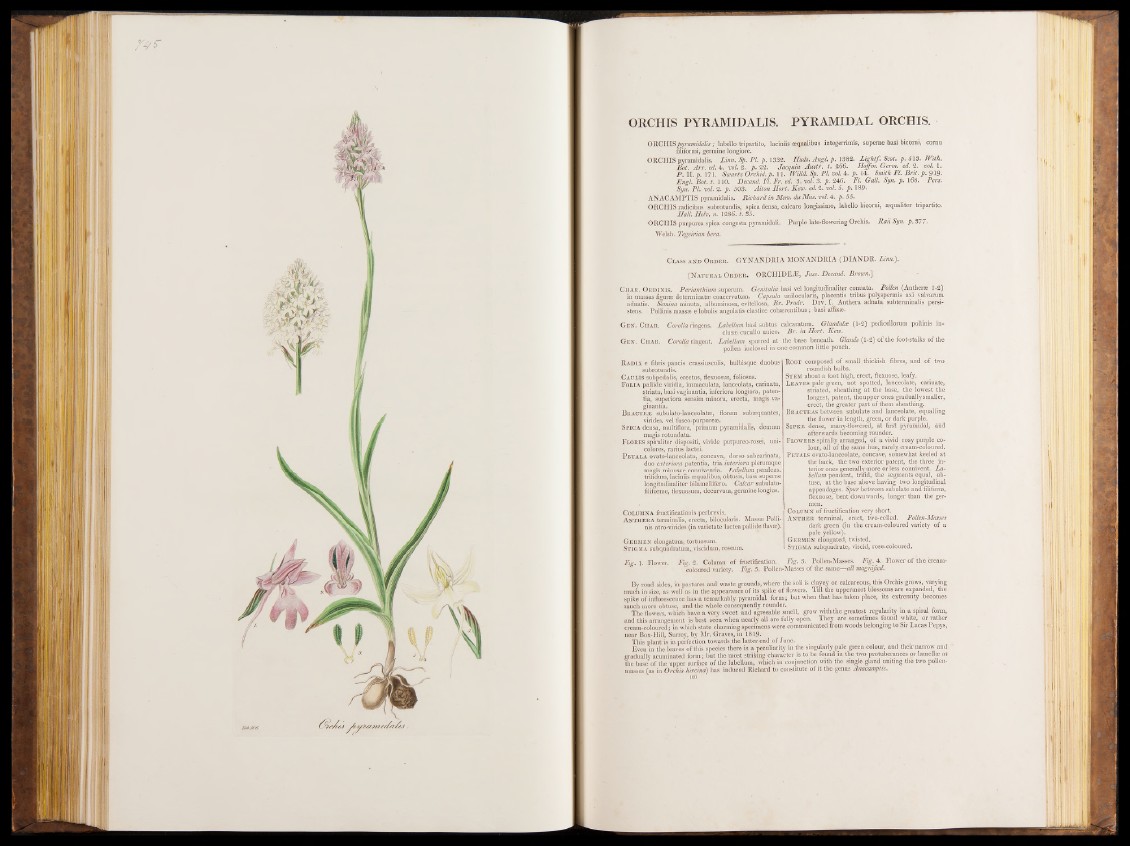
ORCHIS PYRAMIDALIS. PYRAMIDAL ORCHIS.
ORCHIS pyramidalis; labello tripartite, laciniis mqualibus integerrimis, superae basi bicorni, cornu
fiUformi, germine longiore.
ORCHIS pyramidalis. Linn. Sp. PI. p . 1332. Huds.Angl. p. 1382. L ig h t/. Scot. p. 5 13. With.
Bot. Arr.ed .4 -. ml. 2. p. 22. Jacquin Austr. t. 266. Hoffm. Germ. ed. 2. ml. 1.
P . I I. p. 171. Swartz Orchid, p. 11. Willd. Sp. PI. ml. 4. p . 14. Smith FI. B r it.p . 919.
Engl. Bot. t. 110. Decand. Fl. Fr. ed. 3. ml. 3. p. 246. Fl. Gall. Syn. p. 168. Pers.
Syn. P I.-ml. 2. p. 503. Aiton Hort. Kew. ed. 2. ml. 5. p. 189.
ANACAMPTIS pyramidalis. Richard in Mem. du Mus. ml. 4. p. 55.
ORCHIS radicibus subrotundis, spica densa, calcare longissimo, labello bicorni, tequaliter tripartite.
Hall. Helv. n. 1286. t. 35.
ORCHIS purpurea spica congesta pyramidali. Purple late-flowering Orchis. Rail Syn. p. 377.
Welsh. Tegeirian her a.
C lass a n d Or d e r . G Y N A N D R IA M ONANDRIA (D IA N D R . Linn.).
[N atural Ord e r . ORCHIDEÆ, Juss. Decand. Brown.)
Ch a r . Or d in is . Perianthium superum. Genitalia basi vel longitudinaliter connata. Pollen (Antheræ 1-2)
in massas figuræ determinate coacervatum. Capsula unilocularis, placentis tribus polyspermis axi valvarum
adnatis. Semina minuta, albuminosa, evitellosa, B r . Prodr. D iv . I. Anthera adnata subterminalis persi-
stens. Pollinis massæ e lobulis angnlatis elastice cohærentibus ; bàsi aflixæ.
Ge n . Ch a r . Corolla rinsens. Labellum basi subtus calcaratum. Glandules (1-2) pedicellorum pollinis in-
, clusas cucullo unico.
G e n . Ch a r . Corolla ringent. Labellum spurred at
pollen inclosed in oi
R ad ix e fibris paucis crassiusculis, bulbisque duobus1
' subrotundis.
Caulis subpedalis, erectus, flexuosus, foliosus.
F olia pallide viridia, immaculata, lanceolata, carinata,
striata, basi vaginantia, inferiora longiora, patent
e , superiora sensim minora, erecta, magis vaginantia.
Bracteæ subulato-lanceolatæ, florem subæquantes,
virides, vel fusco-purpureæ.
Sp ica densa, multiflora, primum pyramidalis, demum
magis rotundata.
F lores spiraliter dispositi, vivide purpureo-rosei, unicolores,
rarius lactei.
P etala ovato-lanceolata, concava, dorso subcarinata,
duo exteriora patentia, tria interiora plerumque
magis minusve conniventia. Labellum pendens,
trifidum, laciniis æqualibus, obtusis, basi superne
longitudinaliter bilamellifero. Calcar subulato-
filiforme, flexuosum, decurvum, germinelongius.
CoLUMNA fructificationis perbrevis.
Anthera terminate, erecta, bilocularis. Massse Pollinis
atro-virides (in varietate lactea pallide flavas).
Ge rm en elongatum, tortuosum.
Stigma subquadratum,viscidum, roseum.
Fig. 1. Flower. Fig. 2. Column of fructification.
coloured variety. Fig. 5. Pollen-
B r . in Hort. Kew.
he base beneath. Glands (1-2) of the foot-stalks of the
e common little pouch.
Root composed of small thickish fibres, and of two
roundish bulbs.
Stem about a foot high, erect, flexuose, leafy.
Leaves pale green, not spotted, lanceolate, carinate,
striated, sheathing a t the base, the lowest the
longest, patent, the upper ones gradually smaller,
erect, the greater part of them sheathing.
Bracteas between subulate and lanceolate, equalling
the flower in length, green, or dark purple.
Sipk e dense, many-flowered, a t first pyramidal, and
afterwards becoming rounder.
Flowers spirally arranged, of a vivid rosy purple colour,
all of the same hue, rarely cream-coloured.
P etals ovato-lanceolate, concave, somewhat keeled at
the back, the two exterior patent, the three interior
ones generally more or less connivent. L a bellum
pendent, trifid, the segments equal, obtuse,
at the base above having two longitudinal
appendages. Spur between subulate and filiform,
flexuose, bent downwards, longer than the ger-
Column of fructification very short.
An t h e r terminal, erect, two-celled. Pollen-Masses
dark green (in the cream-coloured variety of a
pale yellow).
Ge rmen elongated, twisted.
St igma subquadrate, viscid, rose-coloured.
Fig. 3. Pollen-Masses. Fig. 4. Flower of the cream-
Masses of the same—all magnified.
By road sides, in pastures and waste grounds, where the soil is clayey or calcareous, this Orchis grows, varying
much in size, as well as in the appearance of its spike of flowers. Till the uppermost blossoms are expanded, the
spike of inflorescence has a remarkably pyramidal form; but when that has taken place, its extremity becomes
much more obtuse, and the whole consequently rounder. . .
The flowers, which have a very sweet and agreeable smell, grow with the greatest regularity in a spiral form,
and this arrangement is best seen when nearly all are fully open. They are sometimes found white, or rather
cream-coloured; in which state charming specimens were communicated from woods belonging to Sir Lucas Pepys,
near Box-IIill, Surrey, by Mr. Graves, in 1819.
This plant is in perfection towards the latter end of June.
Even in the leaves of this species there is a peculiarity in.the singularly pale green colour, and their narrow and
gradually acuminated form ; but the most striking character is to be found in the two protuberances or lamellæ at
the base of the upper surface of the labellum, which in conjunction with the single gland uniting the two pollen-
masses (as in Orchis hircina) has induced Richard to constitute of it the genus Anacamptis.
106